












introduction
What Makes Something Bohemian? 12 how to set the table, build your collection, and throw a party
A Brief History of Entertaining 16 Setting the Table 18 Building an Entertaining and Servingware Collection 20
How to Bring Your Bohemian Vibe to Your Tabletop 34 Napkin Folds 42 Planning the Get-Together 53 The Bar 56 party ideas through the seasons Fall 62
Harvest Party 64 How to Dye Your Own Napkins 72 Taco Bar Fiesta 74
Moroccan Tapas Party 82
Gratitude-Filled Thanksgiving 96
Winter 106 Colorful, Modern Christmas Dinner 108 Medieval Rustic Feast 118
Cozy Winter Brunch 124
Après Ski Party 130
How to Make Block-Print Napkins 136
Spring 138 Springtime Garden Fête 140 Shareable Takeout Party 146 Fried-Everything Party 152 Ladies Wine Tasting 160 How to Select Wine 167 Summer 170 Portable Picnic Party 172 Tuscan Tavola 178 How to Build the Perfect Cheese Board 188 Summer BBQ Bash 192 Bohemian Backyard Blowout 200
resources & post-party tips Cleaning Up Post-Party 210 Cleaning Vintage or Thrifted Finds for Use 211 Taking Care of Your Collection 212
Where to Shop for Your Tabletop 214
Finding Inspiration for Your Event 215
Resources 216
Acknowledgments 220 About the Author 221 Party Planning Tear Sheet 223

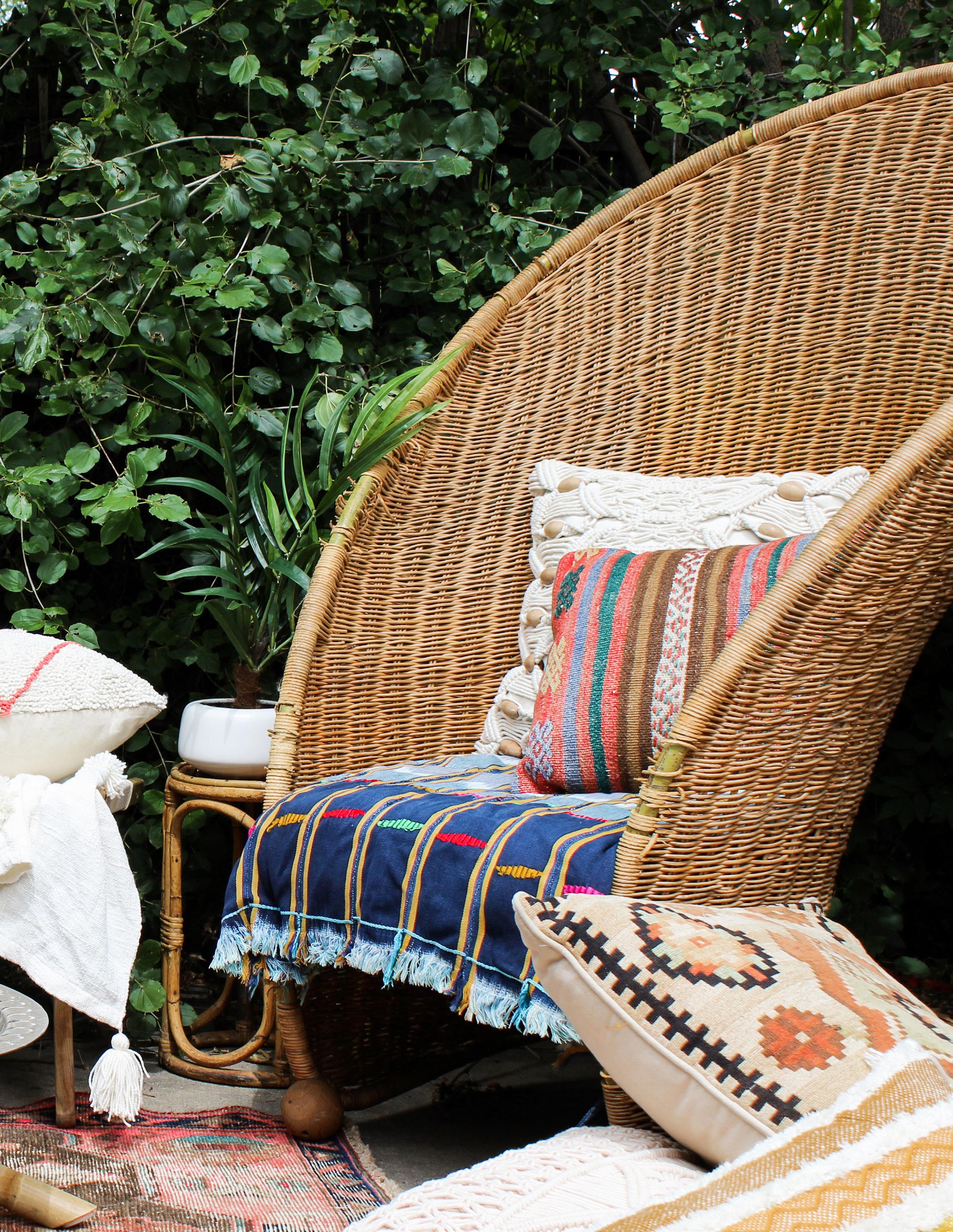
Being bohemian does not mean throwing out all the rules to live a carefree, hairylegged life (though it can mean that, if you like). More often, it means that you simply bend and embellish the standard design rules with your own preferences, experiences, and conveniences more than your un-bohemian neighbor might.
The general principles of design are taught to most interior designers or artists in their first class. It is what comes naturally to all of those people known to “have the eye.”
These days, we likely recognize these principles and picture them through our favorite social media accounts. Bohemian design and living still hold true to these rules but incorporate the following characteristics.
When it comes to creating interest and rhythm in a space or on a table, bohemians use all of the tools in the toolbox: color, shapes, texture—often all together, to create a layered experience. Picture stacked rugs on the floor, a painted wall mural behind hung photos, and big bold-colored furniture in a stark, white-walled room. Combinations as unique as each person, but all bold.
Bohemians honor sustainability in their goods, which means they are either recycled, coined “vintage,” or recently handmade by someone paid a fair wage. Our belongings speak to our values. Concerns about waste, pollution, and treatment of workers are important to the story we tell through our purchases. We want goods that can withstand normal day-today living, and if it has survived thirty-plus years in someone else’s home, it will likely withstand another thirty years. Not to quote every grandparent in the world, but: they just don’t make things the way they used to. Plus, when you find a vintage, thrifted, or antique piece, it is likely unique and one of a kind, which makes it even more special.
With the mix of materials, colors, patterns, textures, and eras, the vibe stays interesting and nostalgic, yet modern. Just like our lives. Bohemians design their homes, events, and wardrobe to match their actual lives—and our lives are complicated, compelling, and contrasting. Bohemian style can be very relaxed and casual on one end, yet highly thought-out and detailed on the other. It is the perfect blend of life and design.
1. REPETITION: Repeating elements like color, shape, and textures unify spaces by creating a rhythm in the design with a consistent visual and physical experience.
2. BALANCE: Equality and symmetry in all elements. Balance can be symmetrical (more formal), asymmetrical (more relaxed), or radial (more focused on one moment).
3. HARMONY: The space and all of its parts relate to and complement each other. All elements act together to create a unified message.
4. PROPORTION AND SCALE: Proportion has to do with the ratio of one design element to another, or one element to the whole. Scale concerns itself with the size of one object compared to another.
5. EMPHASIS: A point of interest that can anchor the design and prevent the distraction of too much, or the boredom of no intentional interest.
Bohemians tie in natural, living things as often as possible. With potted plants, dried florals, rocks, crystals, and more, you can share that organic beauty and energy in any situation. Plant lady is the new cat lady.


Bohemians are often collectors—we want to be surrounded by pieces that are filled with memories or inspiration—and typically not just one small collection, but several. This tendency mimics the feeling of overflowing with life. These material goods are the physical, authentic expression of all that bohemians hold dear. For me, my largest collection is books (not counting all of my “work” collections, which really just allow me a whole other excuse to collect things). Books stand in for memories, hopes, dreams, and all of the good I want to see and contribute to in the world. Most bohemian collections are of small, affordable things, as such items are both easier to hoard and easier to part with if you change your mind.
Bohemian design is original in that it usually entails unique, one-of-a-kind finds, due to the value of recycled and handmade goods. But bohemians also get creative in how they use their goods. Items might not always be used in the traditional way in which most people use them, but instead may be given a new, creative function. Imagine a birdcage as a plant stand, or an old door as a tabletop. Bohemians think outside the box for layout, function, and experience. The feeling of individuality and authenticity supersedes any prior notions of do’s and don’ts. Bohemians are original because of the unique goods and uses for their treasures.
Bohemianism is not about perfection—it is about reality. So bohemian design is just that too. It is a bit messy and imperfect because it is used and enjoyed. Much to my mother’s dismay, I don’t own any furniture polish. I just switch out furniture for pieces that don’t need upkeep, can withstand a lot of cozy nights, and can be layered with accessories to hide their imperfections. Bohemians are well-lived, and so are their goods and surroundings. You don’t ever need to edit your life or your loves for the “supposed-to’s.”

True creativity comes in the challenge of arranging your collection into new and memorable combinations. Your everyday evenings and last-minute entertaining will be built with pieces in your collection. With a strong set, you can create a multitude of combinations with small accents or trimmings for endless possibilities for even the most casual of meals.
• White Dinner Plates
• White Salad Plates
• Wooden Dinner Plates
• Wooden Salad Plates
• Gold Flatware
• Wood and Metal Flatware
• Vintage Flatware
• Water Glasses
• Red Wine Glasses
• Assorted Glassware
• Assorted Napkins
• Assorted Table Linens
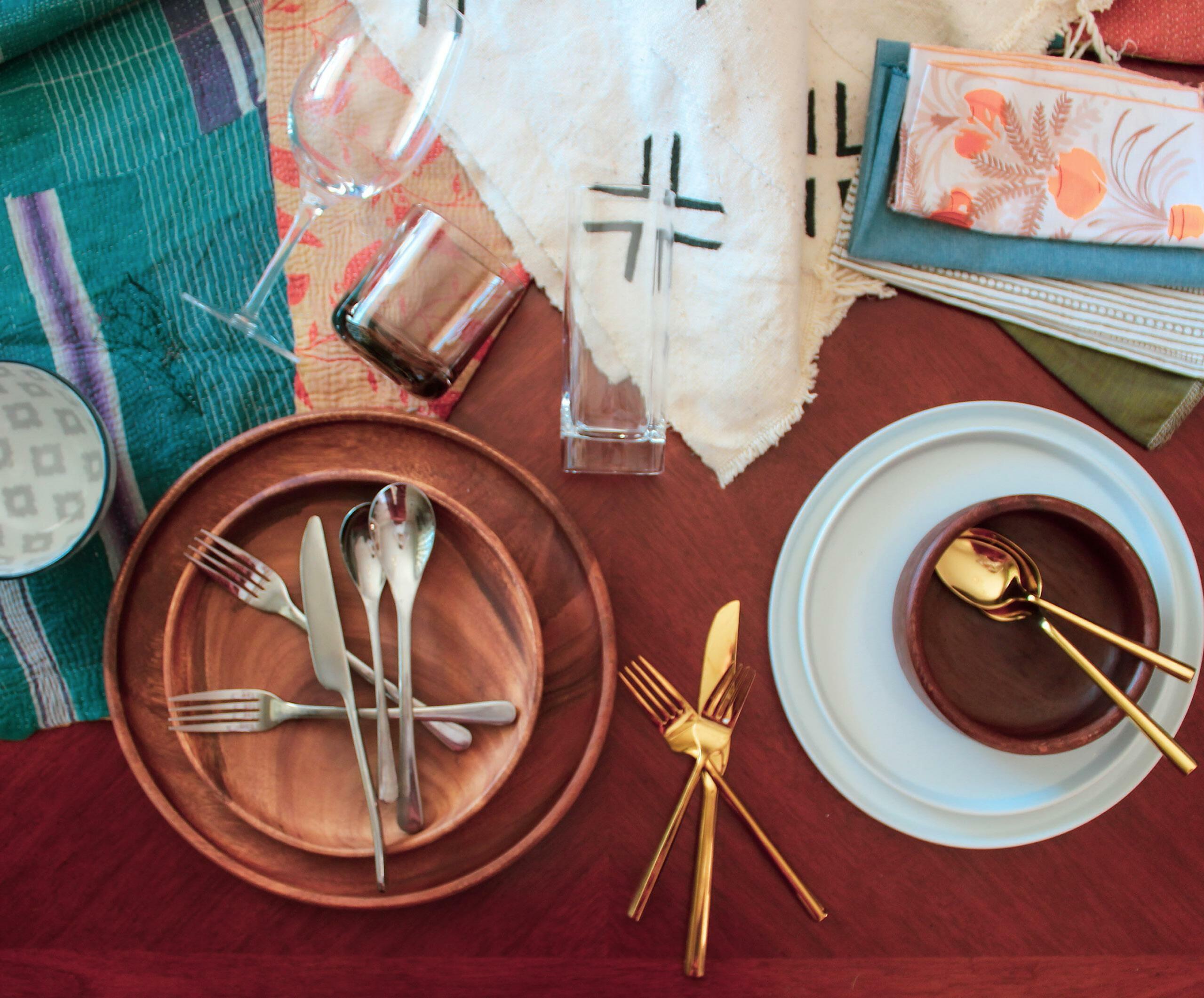


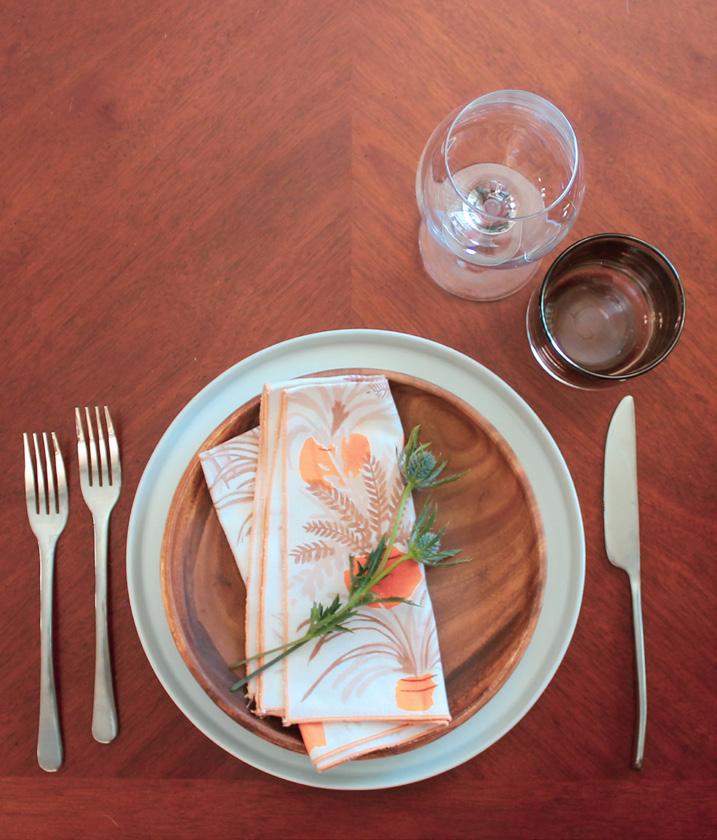



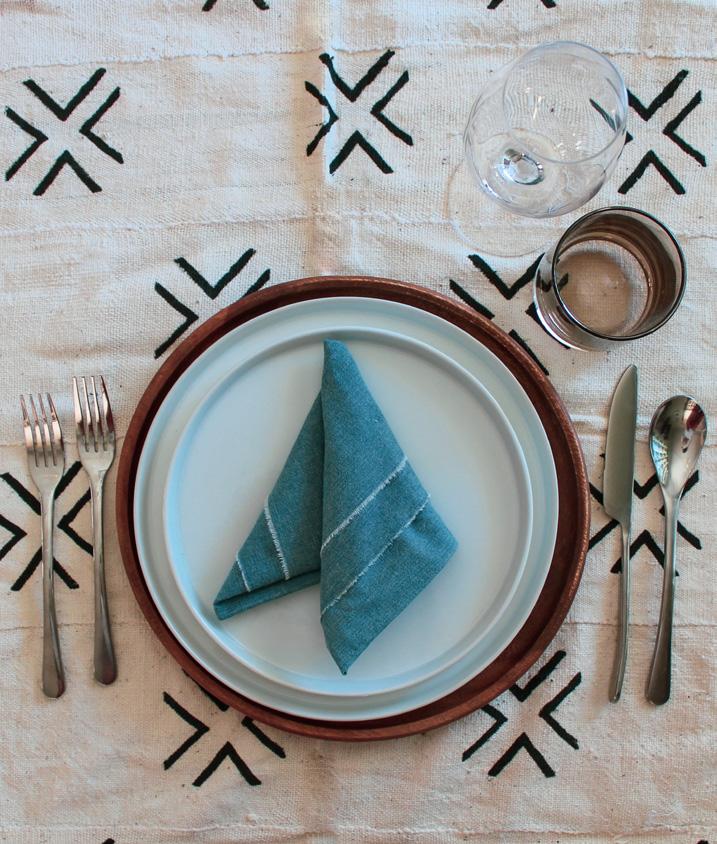




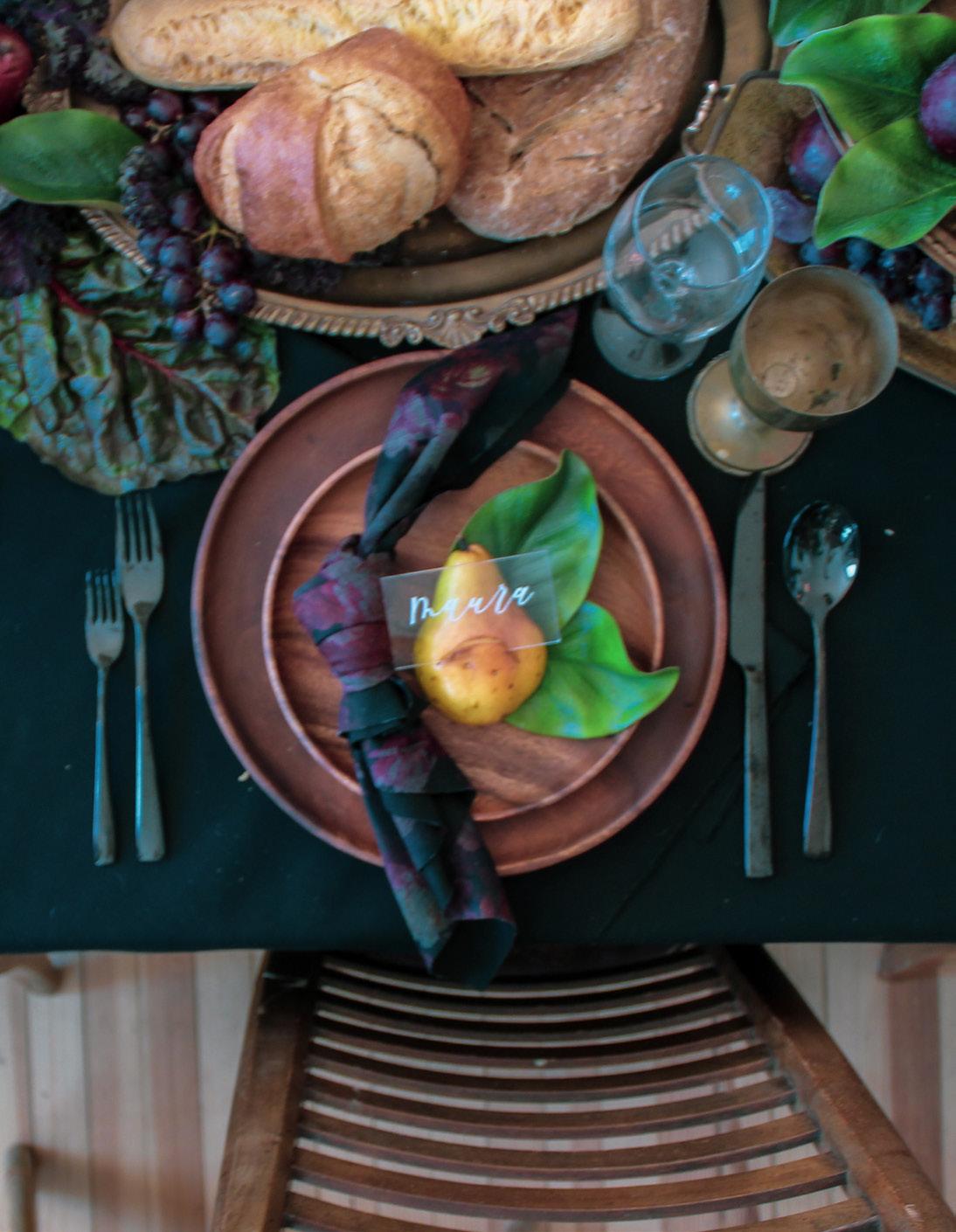


Uniquely folded napkins make a place setting shine—and they are a lot simpler to create than they seem! With just a bit of practice, you can create any unique napkin fold to customize and dress up your table.
Lay the napkin out as a square with the finished side facing down.


Fold the lower edge up about 3 inches, forming a horizontal band at the bottom of the napkin. Fold the upper edge down to meet the edge of the previous fold.
Flip the napkin over, keeping the same sides up and down. Fold the right edge in to the vertical centerline of the napkin. Fold the left edge in to the center.


Fold the left edge over to the right edge.
Arrange the napkin with the larger rectangle at the bottom. Slide flatware into the pocket for each place setting.

Lay the napkin out as a diamond with the finished side facing down. Fold the upper point down to the lower point, forming a triangle.





Holding the middle of the upper edge, fold the left point down to the lower point, then the right point down to the lower point, forming a diamond.
Picking up the napkin from the right and left corners, fold the lower half of the diamond under the upper half, forming a triangle.
Gently bring the lower right and left points closer together, raising the napkin to an upright position.

I always start by planning with the table first, because that is where we’ll spend most of our time during a gathering. The remaining pieces will make up the rest of the night and help you plan accordingly for the preparation so you can enjoy yourself the day of.
Bohemianism translated to the plate incorporates a few core characteristics: seasonal ingredients, reasonably easy to put together, and full of flavor to inspire conversations and memories. Remember, this is about memory-making, not a Michelin star. Sometimes the tastiest food is the simplest, so long as you use fresh and seasonal ingredients.
When planning your menu, suit your own strengths. The gathering is about good people and good food, which means you don’t have to make it all by hand. Choose the recipes that you enjoy preparing, and leave the rest to premade goodies or takeout. When deciding what foods to include, be democratic and choose items that appeal to most people and are not finicky in their preparation. Consider your guests’ diets and preferences when selecting your menu, ensuring you offer a good, healthy spread of options in different food groups so no one goes hungry based on their allergies or lifestyle.
To determine how much food and drink to plan for each person, stick to this helpful guide for each course:
Cocktails
2 drinks per hour
Appetizers 8 to 12 appetizers per person
Main Dish 6 oz. per person
Wine half a bottle for each guest
Side Dishes
2 to 4 oz. per person
Dessert 1 piece per person, or 5 oz. of ice cream
Two weeks prior to your gathering is just enough time to send out paper invitations. Formal events demand a more sophisticated invitation, but you can keep the wording simple and inviting like the examples shown here.


Paper invitations are a wonderful tool for pre-planned events, but in this modern, tech-savvy world there are a few more options that can help you to save time on prep and ensure more timely RSVPs. Email-based invites or Facebook events are common and effective for most guests. Group texts can get a little tricky, as some people do not understand the concept of not replying to all. Individual text messages or emails are a good common ground to save on time but still connect personally with your guests. Remember, it is about freedom and enjoyment, and with that comes spontaneity. If you train yourself to believe it is not a real get-together without a paper invite, you’ll miss out on hosting a lot of fun evenings.
A quick thank-you note, call, or text after the event to your guests (or, if you are a guest, to the hostess) is a nice, impressive gesture. We are not too busy to appreciate our people.
The second you decide on hosting, plan the decor and menu. In addition to deciding what to cook, look at the prep time for each item and plan a backwards timeline from the hour you invite people to arrive to the first item that needs to be cooked. All fresh ingredients can be prepped the night before and cooked in the morning. If possible, it’s ideal to cook everything the day of for freshness, but you can spend
the night before washing, prepping, and chopping all the ingredients so you can simply whip it together the next day.
You can also set the table the night before, adding just the fresh or organic decor the next day. I stack all of the pieces on the table the night before, including servingware, with a little sticky note on each piece to help me (and any helper) know what goes in each. I like to set the table right before guests arrive, because it is a way for me to relax and meditate a bit before the guests swarm. Setting the table is one of the more simple tasks for me, but you might find other tasks come easier, and those can be the last things you do before guests arrive.
Florals are both a classic and modern way to make a special statement for any occasion. But they don’t have to be complex works of art to be special. Florals are not just for the table—they can brighten any room your guests will be sharing. Here are the most common ways anyone can bring fresh and organic vibes to any setting:

• small plants
• store-bought arrangement-turned-centerpiece
• greenery on the table

• bud vases
• wildflowers/other adornments from outside
• dried flowers for reuse
Almost anything can be made into a vase for your floral arrangements. If it does not hold water, simply insert a plastic or glass container, or even a reusable food storage bag.

• Use florals that are as fresh as possible. If you are foraging, collect florals in the morning when their water content is highest. If you are purchasing, look for crisp bright green stems; the blooms should be perky and the petals free from dark edges. Don’t select stems with closed buds, as they often never open all the way (with the exception of lilies, tulips, and gladiolas).

• Trim the florals to take in the most water. Remove all of the leaves that will be under the water line, placing the florals in lukewarm water as soon as possible. Stems should be cut on the diagonal to increase the surface area
soaking up the water. Woody stems can be hammered or broken for better water intake.
• Picture an imaginary outline as your arrangement shape. Begin by placing the basic outline greenery and then add in stems, considering height and color, while picturing a basic outline shape of the entire arrangement. Knowing when to stop is vital, and learned over time. Don’t try too hard, or the florals will look like old-timely funeral arrangements. Bright colors make bold statements, and irregularity can add interest and charm. The most important factor for your arrangement is to repeat the natural, organic line and form of the flowers.
For seamless party planning, see the party planning sheet in the back of the book (page 223).
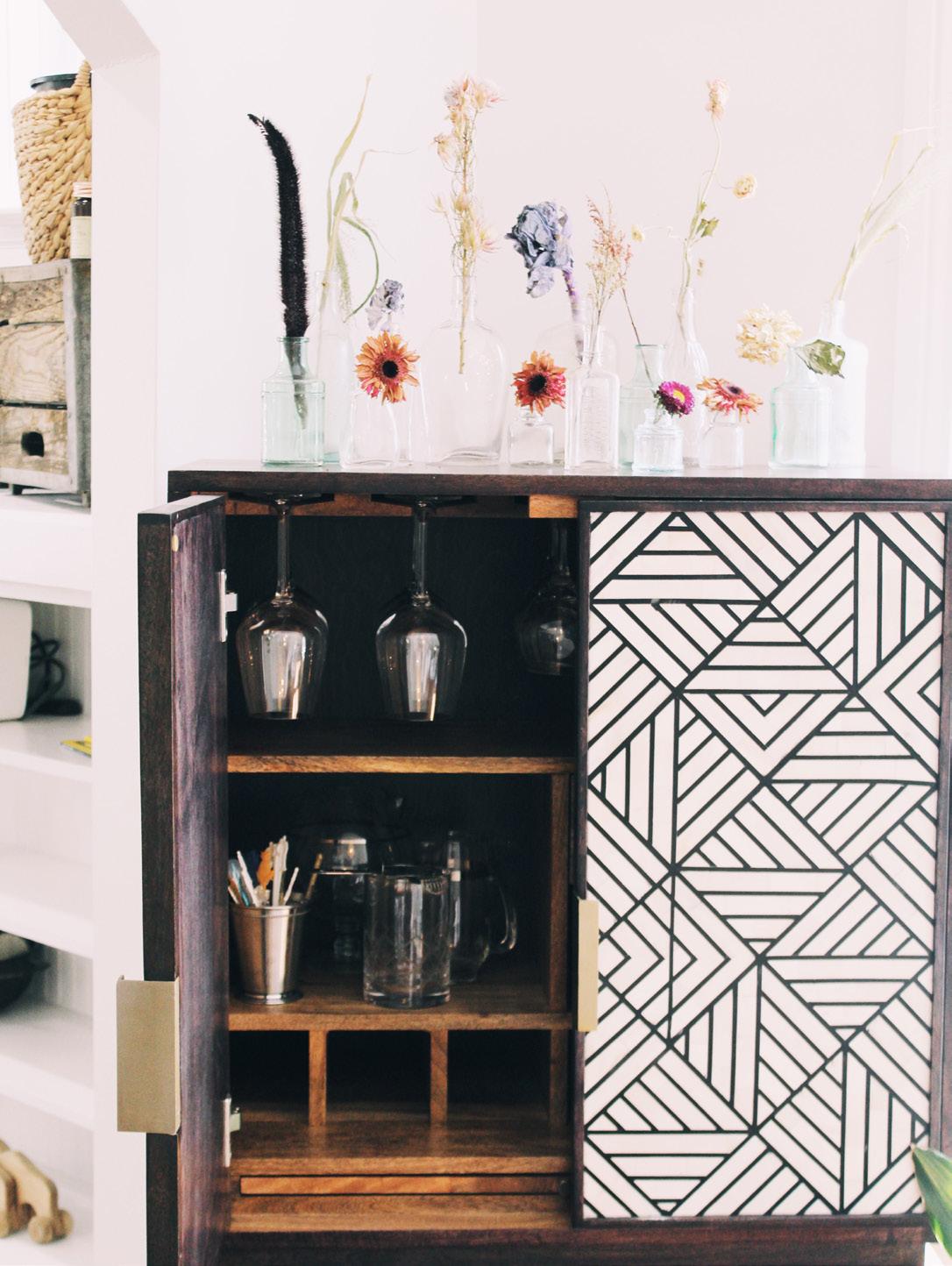
Two drinks per hour per person is a loose rule to plan by, but the true amount of liquor needed depends on the type of party, the length of the event, and what type of food you will be serving. Obviously, a cocktail party with light snacks means there is more time to consume the libations, while a formal dinner leaves less time for cocktails and more time for wine paired with your courses. The bar setup, like the table setting and buffet table, should be easy to use and invite people to feel comfortable with an old classic, or to explore a new twist. For small dinner parties, set up beverage supplies on a cart, small table, or counter and either let it be self-serve or serve it yourself as the host. Place the bar at the center of the party for easy service, or away from the crowd in a non-congested area of the party.
As far as cocktail napkins, paper napkins can go quickly— plan for two to three per person. Guests are more likely to hold onto a cloth cocktail napkin for several servings through the night. Having a unique array of napkin designs can also allow them to serve as an informal name tag, so guests can always keep an eye on their glass.
Commercially purchased ice makes for a fresher-tasting drink than the ice from your freezer, which could be tainted by frozen food. If you are mainly serving cocktails, plan for 3/4 to 1 pound of ice per guest. No need for fancy ice chests or buckets—anything can become a chilled container if first lined with plastic and then aluminum foil to keep it chilled. You’ll want a well-stocked bar of all the classics. Geographical or seasonal factors may call for a few unique add-ons, but the chart shown here is a good base to go by.

bottle of wine (750 milliliters) four 6-oz. drinks
bottle of liquor (750 milliliters) seventeen 1 ½-oz. drinks
bottle of mixer (10 ounces) ten 1-oz. drinks
bottle of champagne (750 milliliters) 5 servings
case of champagne 30 servings keg of beer 130 to 140 servings gallon of punch 24 servings
VODKA: 2 bottles
SCOTCH: 2 bottles
LIGHT RUM: 2 bottles
DARK RUM: 2 bottles
GIN: 2 bottles
BOURBON: 2 bottles
WHISKEY: 2 bottles
WHITE WINE: 4 bottles
RED WINE: 4 bottles ROSÉ: 2 bottles DRY VERMOUTH: 1 bottle SWEET VERMOUTH: 1 bottle CHAMPAGNE: 4 bottles
AMARETTO: 1 bottle
APEROL: 1 bottle CAMPARI: 1 bottle
COINTREAU: 1 bottle
FERNETBRANCA: 1 bottle
KAHLUA: 1 bottle
ST-GERMAIN: 1 bottle
This chart will get your home bar ready for any cocktail that comes your way. That said, you may way to ease into this set-up as you get more aquanited with different cocktails, particularly in the liquor category.


*Two six packs LAGER: pale lager light lager pilsner amber lager bock dark lager
ALE: wheat beer pale ale bitter amber ale stout porter blonde ale saison
SPARKLING WATER: 6 bottles
CLUB SODA: 6 bottles
TONIC WATER: 2 bottles
GINGER ALE: 2 bottles
COKE: 2 bottles
SIMPLE SYRUP: 1 bottle
Lemon Lime Orange Bitters Maraschino cherries Olives Mint Salt and sugar
